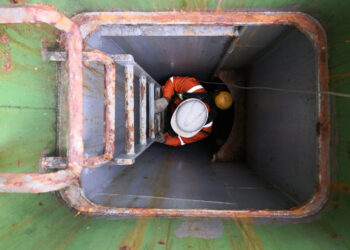London P&I Club – StopLoss No. 60
![]() The ship Inspection Department has noted a general rise in the number of ‘negative Findings’ recorded in relation to the activity of enclosed space entry. the subject has been discussed at length worldwide, and despite a global acceptance of industry standard procedures, incidents continue to occur year-on-year.
The ship Inspection Department has noted a general rise in the number of ‘negative Findings’ recorded in relation to the activity of enclosed space entry. the subject has been discussed at length worldwide, and despite a global acceptance of industry standard procedures, incidents continue to occur year-on-year.
In the latest issue of its StopLoss Bulletin, the London P&I Club refers to diving accidents as follows:
InspeCtIon ‘Findings’ vary in nature, but the Enclosed Space Entry Permit to Work (PTW) and the associated prescribed steps, regularly present themselves as sources of negative findings in ship inspections. Inspectors are repeatedly presented with the following, even when fully completed PTW forms are presented:
1) Completed single PTWs which purport to cover entry into multiple enclosed spaces
2) Checklists fully completed and signed off by the Responsible Officer and Master, but the required safety equipment is not actually in place
3) No evidence of consideration of how a rescue would be undertaken from the space in the event of an emergency
4) No provision for continuous monitoring of the atmosphere of the space
5) Oxygen/Gas detection equipment presented in either a dubious condition or without proper evidence of calibration to statutory requirements.
Any SMS should provide for a PTW system for enclosed space entry, however, an alarming trend of ‘tick box culture’ has recently been detected in routine ship inspections. The importance of proper consideration of the steps which are required for an entry permit to be granted should not be overlooked.
For example, if it has been determined during a Task Risk Assessment that rescue equipment should be placed at the entrance to the space, the physical positioning of the equipment at the location should be verified by the ‘Responsible Officer’ before the item is checked off as completed. Only when all required provisions have been verified should the Master sign the permit to allow the operation to go ahead.
The exact requirements for each enclosed space entry will vary depending on, amongst other things, the location onboard, status of the ship, concurrent work, the previous contents of the space and the type of work to be conducted in the space. For this reason it is not acceptable practice to allow a single permit to apply to multiple space entries, particularly when these spaces are of a different designation.
The officers who are ‘in charge’ of the operation should, of course, always focus on their primary responsibility, which is to ensure that the operation is conducted as safely as practicable. However, should any further motivation be required, the Club is aware of at least one case where a responsible officer faced criminal charges for allowing an operation to be conducted in an unsafe manner – despite having signed the paperwork suggesting that all necessary safety precautions were in place.
For more information, please view StopLoss issue 60
Source: The London P&I Club


























































